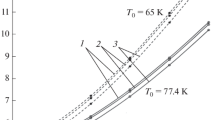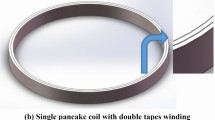Abstract
This article discusses the issue of selection of material for resistive current leads of superconducting magnets. A wide range of their working modes has been considered. It has been demonstrated that copper is by far not the best material for fabrication of current leads, especially operating at currents exceeding the optimum. In such modes, they are prone to rapid overheating, whereas current leads from alloys can withstand current loads exceeding optimum current by several times. Moreover, in the absence of current, the heat gains from current leads fabricated from alloys are 50% lower than those from copper, which is their obvious advantage. The physical reason for this effect is a strong temperature dependence of copper specific resistance, which leads to positive feedback in the course of increase in temperature of current leads. In addition, the current leads fabricated from alloys have other advantages: significantly higher time of their overheating, as well as wider opportunities for increase in the cooling surface.



Similar content being viewed by others
REFERENCES
V. E. Keilin and E. Yu. Klimenko, Cryogenics 6, 222 (1966).
N. Inai, Cryogenics 11, 115 (1969).
J. M. Lock, Cryogenics 11, 438 (1969).
C. K. Tsao, Cryogenics 14, 601 (1974).
M. N. Wilson, Superconducting Magnets (Clarendon, Oxford, 1983), Chap. 11.
H. Kofler and F. Ramsauer, Cryogenics 32, 410 (1992).
A. V. Gavrilin and V. E. Keilin, in MT-15 Proceedings (Science Press, Beijing, China, 1998), p. 1254.
V. V. Senin, Inzh. Fiz. Zh. 29, 1108 (1975).
I. G. Kozhevnikov and L. A. Novitskii, Thermophysical Properties of Materials at Low Temperatures (Mashinostroenie, Moscow, 1982) [in Russian].
A. V. Dudarev, H. H. J. ten Kate, E. W. Boxman, V. E. Keilin, et al., IEEE Appl. Supercond. 12, 1289 (2002).
Funding
This work was supported by the National Research Center Kurchatov Institute and the Rosatom State Corporation within the framework of the federal project titled “Development of Controllable Fusion and Innovative Plasma Technologies.”
Author information
Authors and Affiliations
Corresponding authors
Additional information
Translated by I. Moshkin
Rights and permissions
About this article
Cite this article
Makarenko, M.N., Romanovskii, V.R. Analysis of Permissible Current Loads of Resistive Current Leads of Superconducting Magnetic Systems. Phys. Atom. Nuclei 85 (Suppl 1), S66–S70 (2022). https://doi.org/10.1134/S1063778822130087
Received:
Revised:
Accepted:
Published:
Issue Date:
DOI: https://doi.org/10.1134/S1063778822130087




